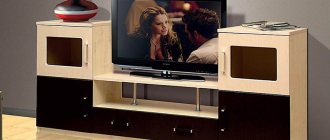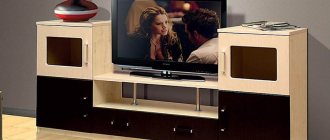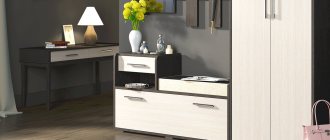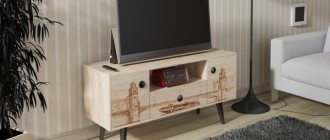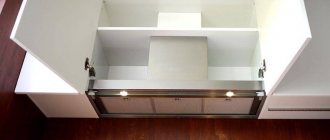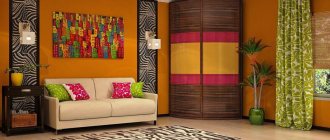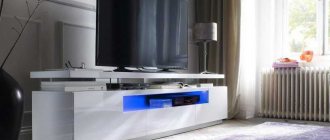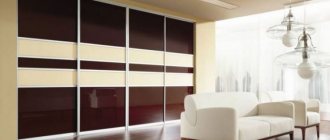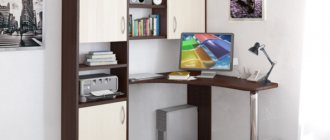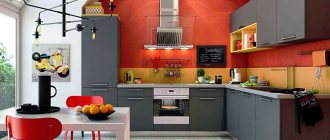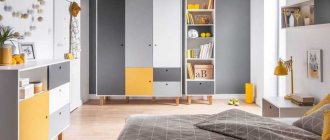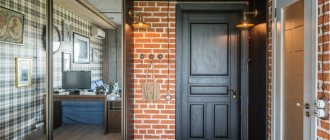<
>
Installing a TV stand in the living room is a fairly classic solution, provided for by most styles. This option will look equally organic in a spacious hall or a small room with a modest footage.
TV stand - advantages
Cabinets are fairly wide cabinets for storing things. However, they are not very tall. TV stands are no exception.
Installing such a piece of furniture provides a number of advantages:
- Pairs well with all types of modern TVs. At the same time, technology remains the dominant element. A correctly selected model will only emphasize its advantages;
- Effective use of footage. This is the most compact piece of furniture traditionally used for living rooms;
<
>
- A wide range of models in any style. You can equally well find a suitable option for a classic setting or with a focus on modern styles;
- Wide range of materials used, including the latest developments;
- Limitless possibilities in terms of decoration;
- A complete storage system with compact dimensions. An ideal solution for homeowners with modest dimensions.
What can be supplied with a hanging TV bedside table?
By request, the next note will be on the topic - a bedside table for audio video equipment. We believe you will like it.
When answering the question of how to choose a hanging TV stand, first decide what you will store in it. A typical storage system includes straight shelves in a configuration with pull-out drawers. The type of things stored depends not least on whether the shelves are open or hidden behind the doors. You can place decor, beautifully bound books, and vases in open areas. It's up to you to decide what to hide in the middle.
In this regard, the main additional equipment of the bedside table. It includes:
- Backlight. Will create an original design. Even if it is not provided in the basic configuration, such an element is easy to assemble on your own;
- Electric points. You will also have to attach them yourself. They will be required at a convenient distance from the TV;
- Niches for equipment. It would be nice if such sections did not have a wall at the back. This helps improve natural air cooling;
- Section for dishes. It will look incredibly beautiful with internal lighting.
There is no need to install large speakers or a subwoofer on a suspended wall. The oscillations and vibrations they create can result in the bedside table falling or the fasteners loosening.
TV stand frame - design, materials, coatings
The frame of a TV stand is the frame formed after the main parts are assembled. Comprises:
- Sidewalls (standard 2 pieces);
- The upper horizon, which can serve as a functional shelf for the cabinets;
- Lower horizon;
- Rear wall.
The quality and rigidity of the connection of all elements affects the stability of the furniture. Made from the following types of materials:
- Natural wood;
- Wood or particle boards (MDF, chipboard, fiberboard);
- Lacquered coated boards (chipboard, LMDF);
- Plastic;
- Thick tempered glass;
- Synthetic analogues of glass;
- Metals. Rarely used on their own. Most often they are combined with glass, mirrors, and wood.
Many materials require an additional protective layer. For these purposes the following is used:
- Painting with enamels;
- Multilayer varnishing;
- Polymerization (plastic coating);
- Lamination (thermally fixed film).
Additional functional elements
If you have to frequently move furniture while cleaning, then purchase a mobile cabinet on wheels.
To hide a huge amount of wires and cables, select a cabinet with holes on the back wall and use a cable channel.
We hope that after reading this article you understand how important it is that the TV stand fully meets your needs and the interior of the room. We wish you a successful purchase and pleasant TV viewing!
Shapes and sizes of modern TV stands
When choosing a TV stand, you should take into account the variety of their shapes:
- Geometrically correct. The most used type for floor cabinets;
- Round. Shelves can be elongated or semicircular. Most often, only the front side is rounded, and the back is shaped with an even cut. This makes it easier to position against a wall;
- Shelf type. The traditional case is practically absent. Sometimes all that remains is a narrow vertical bar at the back. Many open shelves are held together using corner posts. A characteristic type for glass structures;
- Complex bookcase. The shelves are not solid at all levels. Some tiers are made from 2 or 3 island shelves with smaller dimensions. In this case, additional steel stops are added;
- Asymmetrical multi-level. Several sections are held together by open long shelves. At the same time, they move sideways. Each section has its own body. A common type for mounted options.
For proper use with the ability to fit a TV stand into the interior, the following dimensions are important:
- Wide. These are considered models with a length of at least 1.2 meters. The largest models reach 3 meters in length. They differ in relatively small parameters in height and depth. Both of these values will fluctuate between 40 – 50 cm;
- Tall. The width starts from 80 cm and is limited to 120 cm. The optimal parameter for height is 85 – 90 cm. Depth rarely exceeds 50 cm;
- Narrow. This is a category from 60 to 80 cm. Using stands with a width of less than 60 cm is dangerous for the TV and the owner. They usually have a low depth parameter. It ranges from 35 to 45 cm. The height can be any, but the average becomes 80 cm;
- Low. This is a traditional option for hanging models. Their height can vary between 30 – 35 cm. The depth is about 40 cm. This is the minimum value. Cabinets with a shallower depth create a risk of the screen installed on it falling. Moreover, such models usually have considerable width (at least 1.4 meters).
What can a wall-hung TV stand be equipped with?
When deciding how to choose a wall-mounted TV stand, first decide what you will store in it. The standard storage system includes straight shelves in combination with drawers. The type of things stored depends not least on whether the shelves are open or hidden behind the doors. In open areas you can place decor, beautifully bound books, and vases. It's up to you to decide what to hide inside.
In this regard, additional equipment of the cabinet is important. This may include:
- Backlight. Helps you create an unusual design. Even if it is not provided in the basic configuration, this element is easy to install yourself;
- Sockets. You will also have to attach them yourself. They will be needed at a convenient distance from the TV;
- Niches for equipment. It is desirable that these sections have no back wall. This helps improve natural air cooling;
- Section for dishes. It will look especially beautiful with interior lighting.
There is no need to install large speakers or a subwoofer on a suspended wall. The oscillations and vibrations they create can result in the cabinet falling or the fasteners loosening.
Varieties of designs according to placement method
There are the following types of installation of TV stands:
- Floor-standing. The bedside table is installed along the wall directly on the floor;
- Hanging. Creates the effect of “hovering” in the air. Attached to the wall.
The main element of support is the legs. The stability of the entire structure depends on their quality. May be as follows:
- Legs. 4 straight or curved supports attached to the outer corners of the body. All unevenness in the floor is responded to by shakyness and swaying of the furniture;
- Stops. Metal support elements located at an angle to the bottom of the housing. It looks as if the legs have sagged under the weight of the furniture. Very stable option with a high degree of reliability;
- Regulated. These are special screws with several wide, flat washers. By twisting them, the legs can be made of different heights. Very comfortable on uneven floors. Without screed repair work, the furniture will stand level. Not very beautiful in terms of design;
- Base system. Sidewalls extended by several cm act as legs. A transverse narrow strip is added along the front side - a plinth. Acts as a front stop. Allows you to cut corners on the sidewalls when fitting to the baseboard. The optimal width is 7 cm. Narrower bases will ripple when attached. Under it you can hide the not-so-pretty adjustable screws;
- Rollers. They are equipped with a protective decorative casing and a system of stops against arbitrary rolling. Significantly increase the mobility of long cabinets placed on the floor.
For wall-mounted TV stands, the quality of the fasteners comes first. Not so long ago, the choice was limited to several types of anchor bolts. Now in stores you can find up to a dozen types of special furniture canopies. They are distinguished by high resistance to loads. Can withstand at least 120 kg. Designed specifically for hanging the lower tiers of furniture sets. They consist of 2 plates, movably fastened using special bolts. Equipped with additional end caps. Fastened with 4 self-tapping screws. After installation, the cabinet can be moved up or forward by distances of up to 2 - 2.5 cm.
Canopies should always be installed in pairs along the edges. Installing one fastening in the center may result in damage to the furniture body due to improper load distribution. Wide cabinets will warp like scales. In very long versions (over 2 meters), additional fastenings are added in the center.
Methods of fastening to the wall surface
Until recently, the only way to place a large bedside table on the wall surface was with anchors. It didn't look very nice. And reliability fully depended on the quality properties of the partition masonry. Currently, furniture roof overhangs are in great demand for these purposes. They are 2 plates, movably interlocked. Intentionally designed for hanging lower tiers of furniture. One mount can withstand up to 120 kg of load. After installation work, it is possible to adjust the position of the bedside table in depth and height by 2 cm in each direction. Additionally equipped with a pair of plugs. Despite the serious weight requirements, never install one roof overhang in the very center. Use at least 2 pieces along the edges. Equal load distribution will increase the quality of suspension.
No matter how good the selected fasteners are, the quality of the wall also affects the final result. The partition must be load-bearing. Failure to comply with this rule may result in very expensive repairs and problems with neighbors.
TV placement options
There are several ways to place the TV:
- Surface mounted. To do this, the screen must be equipped with a support leg. Ideally it should be rotating. This way you can adjust the angle of rotation;
- On the wall. For small screens, canopies or dowels are suitable. On durable brickwork, it is better to use steel options. For cinder blocks or foam blocks, purchase propylene dowels. But, for all TVs whose diagonal is equal to or exceeds 50 cm, special brackets are used. Many of them provide the ability to extend the screen forward, rotate it sideways, or even rotate it around its axis by 90° in both directions. Such options will of course cost more, but the ease of use and reliability will be at the proper level;
- Pantograph. In this case, the screen can also be moved in height with a significant spread. But, for this, the screen must have special side “handles” (recesses). Equipping with special holders (beam suspension) is also a prerequisite. Otherwise, the entire structure will lose the lion's share of reliability;
- In a niche. There will be difficulties in providing ventilation and cooling. There should be free space behind the screen. Due to overheating, not only plasma panels break prematurely. The LED screen in long overheating mode will respond to you with delamination. Any master can determine this. The TV will simply “fly out” of the warranty, and delaminated screens cannot be repaired.
On the back of the TV there are special places for mounting the bracket. Even TVs with legs have them. Standard bolts are screwed into them as standard. Only use them. Installing your own may result in a warranty denial. Also, the absence of a technician’s mark on mounting the screen on the bracket may cause the device to be excluded from warranty service.
TV screen in the kitchen
In the kitchen, hallway and other small rooms, it is permissible to hang the TV at a level of 150–170 cm. It is assumed that in such rooms TV viewing will be infrequent and short-term. Therefore, safety and harmonious screen placement criteria come to the fore. It should be in a place convenient for viewing both from the kitchen work area and from the dining table.
If you plan to watch TV while standing, hang it at human height on a free section of the wall, away from the stove. In this case, the TV stand can serve as a stand and storage for kitchen accessories. Install it at a convenient height, usually on the same level as the rest of the furniture.
Facades
All TV stands in the living room have several types of facade opening systems:
- Swing. The doors are attached with special hinges to the body. They open outward towards themselves. They will take up a lot of space. Reliable fastening method. Do not open the doors jerkily;
- Folding. The hinges are moved down the sash, and a pair of breakable side holders are added to the sides. When open, they also “eat up” enough space. Open down until the position lock clicks;
- Sliding. The doors are fastened with hinges in pairs. Moves sideways using the top roller. Folds like a book.
Pay maximum attention to decor:
- The widest variety of decorative glass. Matted, milky, patterned, bent. Richest choice;
- Mirrors. Can be colored or tinted. They will make the room visually wider and brighter;
- Hand painted. An original bright spot that will definitely attract attention;
- Photo printing. The design can be applied to all types of materials;
- Veneering. The material is expensive, capricious, but will give your furniture a luxurious appearance.
Optimal shape
You can find coasters of all sorts of shapes: round, rectangular, polygonal, abstract shapes, with sharp and rounded edges. The choice depends on the interior and layout. If all the furniture has smooth curves, then you should choose an oval cabinet. If you plan to place the TV in a corner, then it is better to purchase a corner TV stand.
Internal filling
A combination of open and closed straight shelves is considered classic for a cabinet. At the same time, drawers of various sizes can be added to the storage system. This cabinet is suitable for arranging decor, magazines, and books. The presence of glass sections for dishes or a mini bar will add not only functionality to the cabinet, but also style. Most models are equipped with through sections (without a back wall) for accompanying equipment or speakers.
Additional equipment for television stands
Many TV stands are additionally equipped with:
- Turning platform. This is an oval overlay for the top panel. Almost identical in length. It is attached using a special semicircular element. It can tilt at different angles or rotate around its own axis. A good option for corner cabinets or TVs with a fixed leg;
- TV holder. This is a special rack equipped with a bracket with several degrees of freedom. The stand itself can also be height-adjustable. In this case, there is no problem with attaching the bracket to the wall;
- Backlight. Will give additional originality. It is quite easy to equip it yourself. The main thing is not to light up the TV screen.
Rules for placing a TV stand in the interior of a room
When choosing a place for a TV stand, you will have to focus on a number of the following requirements:
- The selected location should offer a high-quality view. No other tall furniture or partitions should be in view;
- No windows on the sides and opposite the screen. This is due to the fact that even modern screens will respond to direct sunlight with deterioration in image quality and color disturbance. Watching programs in overexposed conditions will quickly cause pain in the eyes;
- The screen must be hung at a distance from the floor of at least 1.2 m for living rooms and 1 m for bedrooms. Based on this, the height of the cabinet is selected. This problem disappears when you mount the TV to the wall. In any case, the upper third of the screen should be strictly at eye level of the person sitting opposite;
<
>
- An equally important condition is the distance to the TV. The easiest way to calculate this value yourself. Measure the screen diagonal. Then multiply the value by 3, or better yet, by 4. The resulting figure is the required meters. For example, a 42-inch diagonal requires the screen to be placed 2.4 m from the seat. This is for image quality with a resolution of 720. If the resolution is 1080, then you can reduce the footage to 1.7 m;
- A coffee table placed opposite the general stylistic direction will add additional charm to the atmosphere;
- Combined placement with two symmetrical side cabinets, display cases or narrow wall cabinets will give the wall a harmonious, complete look.
Styling options
It is very important when decorating the interior to choose the right style:
- Classic. If you're not very design-savvy, then this is just what the doctor ordered. Correct shapes, slightly rounded corners, straight silhouettes. It is almost impossible to spoil the overall appearance of this austere furniture. The decor is used strictly in moderation;
- Neo Baroque. A combination of pretentious palace styles with modern materials and technologies. The result is high-quality furniture with unusual rounded silhouettes;
- High tech. The futuristic and airy nature of the designs comes first. Lots of glass, chromed steel, bright plastic;
- Modern. Strict cubic shapes. Minimum decor and simplicity. Bright hues. Expensive and pretentious design is not used;
- Country styles. The common thread can be called country music. A large amount of natural wood with a minimum of processing. The decor is simple, as are the silhouettes. Direct, but very memorable style. Artificially aged furniture will do.
Photos in the interior
<
>
Despite the fact that TVs are increasingly “flying up” on the wall, the cabinet remains the most worthy frame for modern technology.
They fit harmoniously into any interior, helping to organize a complete storage system. Construction materials warehouse - plaster at wholesale prices.
Hanging TV stand in the interior - advantages and specifics
By equipping your living room with a hanging TV stand, you will kill several birds with one stone:
- Perfectly combined with flat screens of modern TVs. When placed together, they give a very popular accent to the entire room interior;
- Does not complicate floor cleaning. No dust collects under them;
- Allows you to effectively use space;
- Serves as a complete storage system.
The TV can not only be installed on the top panel of the bedside table. A flat screen suspended above a cabinet looks much more unusual. To do this, special spider fasteners are used. The only downside to this approach is still there. Wires will be visible. But the luxurious appearance partly pays for it.
In the next article we will talk about the topic - a bedside table for video audio equipment. Let's try to describe this topic in more detail.
By request, the next note will be on the topic of purchasing a bedside table for a kitchen sink. We believe you will like it.
If you have the desire and skillful hands, you can equip the wire from the TV with decorative components. In this case, it will become an additional decoration. Although, more often they simply make hidden wiring, or cover them with elements of hanging shelves and cabinets.
